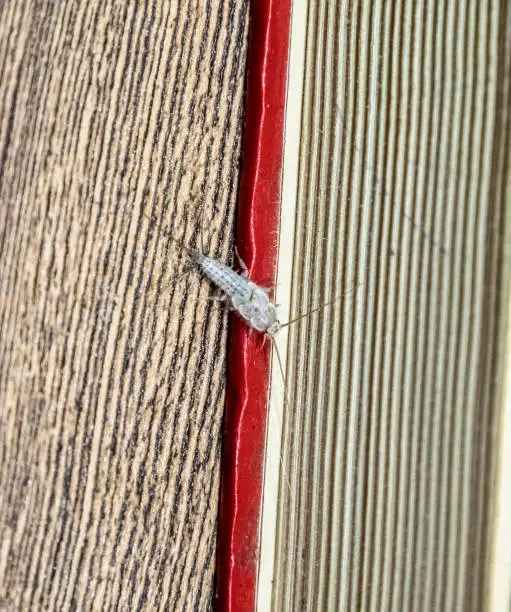Secured Plastic Plant Clip, 2024 Upgrade Plant Support Clips, Garden Clips for Climbing Plants, Plastic Trellis Clips Plant Support Clips Tomato Grape Vine Vegetables Plant Fixing Clips (100, White)
$13.99 (as of April 22, 2024 18:01 GMT +00:00 - More infoProduct prices and availability are accurate as of the date/time indicated and are subject to change. Any price and availability information displayed on [relevant Amazon Site(s), as applicable] at the time of purchase will apply to the purchase of this product.)Silverfish are tiny, wingless insects that can cause damage to household items such as books, clothing, and wallpaper. They are nocturnal and prefer damp environments, making them difficult to spot until they have already caused significant damage. In this article, we will discuss the behavior of silverfish bugs, the signs of an infestation, and how to prevent silverfish damage.
Understanding the Behavior of Silverfish
Silverfish are ancient insects that have been around for over 400 million years. They are small, about half an inch long, and are silver or gray in color. Silverfish have long, thin bodies and move very quickly, making them difficult to catch.
They are attracted to humid environments and can be found in bathrooms, kitchens, basements, and attics. Silverfish are nocturnal and move quickly, making them difficult to spot during the day.
Silverfish are also known for their diet. They feed on carbohydrates, particularly sugars and starches, which can be found in household items such as paper, wallpaper, books, and clothing. And they also feed on dead insects and skin flakes, making them a common problem in homes.
They are particularly fond of book bindings, wallpaper paste, and cardboard. This is why they are often found in libraries and other places where paper materials are stored.
Signs of Silverfish Infestation
There are several signs that can indicate a silverfish infestation. Here are some of the most common:
- Presence of silverfish: If you see a silverfish in your home or business, it is likely that there are more hiding somewhere.
- Shed skin: Silverfish shed their skin as they grow, and you may find small, shiny skins in areas where they have been active.
- Yellow stains: Silverfish excrete a yellowish substance that can leave stains on surfaces where they have been feeding.
Identifying Silverfish Damage
If you suspect that you have a silverfish infestation, it is important to identify the damage they have caused. Here are some common types of damage that can be caused by silverfish:
- Holes in paper materials: Silverfish will eat through paper materials, leaving behind small holes. This can be particularly damaging to books, photographs, and other important documents.
- Damage to fabrics: Silverfish can cause damage to fabrics by eating through them or leaving yellow stains. This can be particularly damaging to clothing, curtains, and upholstery.
- Damage to wallpaper: Silverfish will eat through wallpaper paste, causing it to become loose and peel away from the wall.
- Damage to carpets: Silverfish can damage carpets by eating through the fibers or leaving yellow stains.
How to prevent silverfish infestation?
Preventing silverfish infestations requires a combination of tactics. Here are some steps you can take to get rid of silverfish from infesting your home or business:
- Reduce humidity levels: Silverfish thrive in damp environments, so reducing humidity levels can help prevent infestations. Use dehumidifiers or air conditioners to reduce humidity levels in your home or business.
- Store paper materials properly: Silverfish are attracted to paper materials, so it is important to store them properly. Keep books, photographs, and important documents in sealed plastic containers or in areas that are not damp.
- Clean regularly: Regular cleaning can help prevent silverfish infestations by removing the food sources they rely on. Vacuum carpets and floors regularly, and dust shelves and bookcases to remove any food particles.
- Use sticky traps: Sticky traps can be used to catch silverfish and monitor their activity. Place sticky traps in areas where silverfish are likely to hide, such as near baseboards, under sinks, and in closets. Check the traps regularly and dispose of any silverfish that are caught. Using sticky traps can help reduce the silverfish population in your home and prevent an infestation from getting out of control.
- Seal cracks and crevices: Silverfish can enter your home or business through small cracks and crevices. Seal these openings with caulk or other sealants to prevent them from entering.
- Use natural repellents: There are some natural repellents that can help prevent silverfish infestations. Cedar chips, cinnamon sticks, and citrus peels can all be used to repel silverfish.
- Repair leaks: Silverfish are attracted to moisture, so it is important to repair any leaks in your home or business to prevent them from infesting.
The Bottom Line
Silverfish infestations can be a frustrating problem for homeowners and businesses. They can cause significant damage to paper materials, fabrics, and other surfaces. Identifying the signs of silverfish infestation and damage is important in order to prevent further damage from occurring.
By using silverfish sticky pest control products like sticky traps along with other methods mentioned in the article, you can prevent silverfish from infesting your home or business. Remember to regularly monitor your home for signs of silverfish activity, and take action immediately if an infestation is detected.



